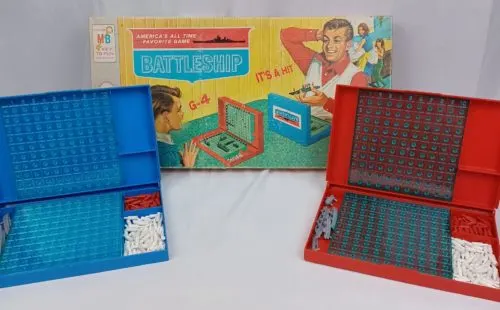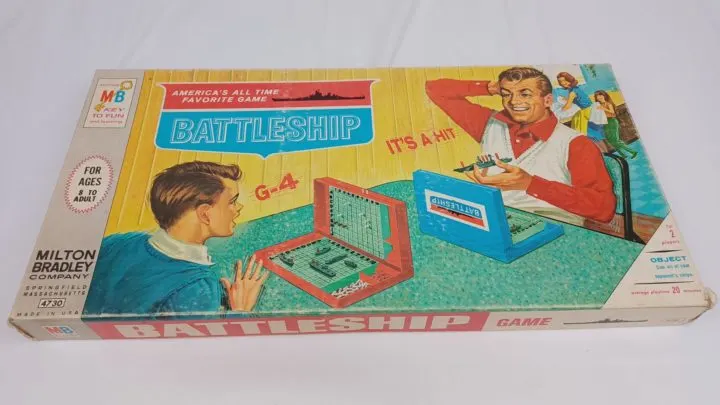Battleship is one of those board games that pretty much everyone has played at least once. The game originally began as a pencil and paper public domain game. In 1967 it became the Milton Bradley game that most people are familiar with.
I have to say that I have never had particularly strong feelings towards Battleship. I remember playing the game every so often when I was a kid. It wasn’t one of my favorite games though. Since I haven’t played Battleship in quite a few years, I decided to give the game a chance to see how it stands up. Battleship is a solid somewhat fun game that was good for its time, even if at times it feels like a glorified guessing game.
For those few of you not already familiar with Battleship, the premise behind the game is quite simple. Two players face off trying to sink the other player’s ships before they can sink yours. Each player places their ships in a grid. Players then take turns calling out a coordinate in the grid. To sink a ship, a player has to call out all of the coordinates corresponding to the ship. The first player to sink all five of their opponent’s ships wins the game.
If you would like to see the complete rules/instructions for the game, check out our Battleship how to play guide.
I am not entirely sure what to think of Battleship. The game is considered a classic for a reason. There are things that I like about it, but it has quite a few issues as well.
On the positive side the game is quite easy to play. If you have a basic understanding of simple coordinate systems, you should have no issue playing the game. In fact most people likely already know how to play the game. For those that don’t, I think the game could be explained in just a couple minutes. The players basically just take turns calling out letter number combinations trying to find where the other player placed their ships. There is nothing complicated about the game. I think this is one of the main reasons Battleship has been a family game classic for many years.
Along with the simple gameplay, comes a game that is one that you can just relax and play. You can’t totally zone out while playing it, but you also don’t have to constantly consider what you should do on your turn. Just make an educated guess at the location of a ship and hope you are right. Battleship is never going to be confused for a deep game. Sometimes it is nice just playing a simple game where you don’t have to analyze a bunch of things before making a decision.
If you would ask a lot of players about Battleship, you likely will get differing thoughts on the game’s strategy versus luck. I am not quite sure how I would describe it either. Ultimately the game has some elements of both. If you carefully analyze how the game works, there are ways to increase your odds of winning Battleship. You could just randomly choose locations. Sometimes this might prove fruitful. Usually you are better off having a strategy for how you are going to search the grid. If you utilize a well thought out strategy, your odds of beating someone randomly guessing will be higher.
Despite there being a benefit to using a strategy when choosing spaces, Battleship still relies on quite a bit of luck. No matter how good your strategy is, it can only go so far. You will ultimately have to get lucky when making guesses. Being able to read the other player’s tendencies can help. There is no way to know for sure where the ships are though unless you are actively cheating. Once you hit a ship it is just a process of elimination to ultimately sink it. Getting that first hit on a ship is kind of random though. Whoever is better at getting those first hits on new ships is likely going to win the game. There is no strategy that is going to overcome bad/unlucky guessing. Ultimately Battleship is a simple guessing game where strategy can somewhat help you.
For this reason Battleship has always been a game that has worked better for families/children than adults. The game’s simplicity means that adults and children can both enjoy the game. With the reliance on luck, children will have a similar chance of winning without the adult having to throw the game.
Battleship also plays relatively quickly. It ultimately depends on how well the players guess, but I would guess you could finish most games within 20-30 minutes. That seems about the right length for this type of game. If it was considerably longer, it would start to drag.
Unfortunately I don’t know if Battleship has enough strategy for adults. I can see adults still having some fun with the game. If you are looking for an easy to play game where you don’t have to put too much thought into what you are doing, you can have fun playing it. I just wish there was a little more strategy to the game. This would have made the game more engaging for adults as it would feel like more than just a simple guessing game.
Everyone might not be familiar with this, but Battleship actually has two variant games. This is because these are not specifically outlined in the rules for quite a few Battleship games. Basically the variant rules are based around players getting to take several shots on their turn. Each player will start the game with five shots each turn. As the game progresses you will get less shots after each ship is sunk. Thus these variant rules emphasize sinking the other player’s ships as quickly as possible.
I had mixed feelings about these variant rules. On the positive side they do make the game play quite a bit quicker. Getting five shots a turn instead of one can make a pretty big difference. This may change how you approach choosing spaces as you might want to spread out your shots to increase the odds of getting a hit. This also rewards the player who gets out to an early start.
The problem with Battleship’s variant rules is the fact that they make the leader problem even worse. If one player can start sinking ships faster than the other, they will get to take more shots than their opponent each turn. This means they have a better chance of getting a hit. This can spiral out of control quickly especially if one player does a better job of finding ships. Eventually it can get to the point where one player gets so far ahead that the other player has no chance of ever catching up. This leads to kind of an anti-climatic ending.
As for the game’s components I can’t say a lot about them. There have been many different versions of the game released over the years. The quality of the components likely will vary between the different versions. The game I used for this review is the 1967 edition which is the original Milton Bradley version of the game. The 1967 version of the game is pretty typical. It is nice that the game gives you two different gameboards with storage trays. This allows you to store everything you need in each gameboard. The components are all made of plastic, but they are solid enough.
I ultimately have some conflicting feelings towards Battleship. While there have been better games made since Battleship first came out, the game has some redeeming qualities. It is quite easy to play where children and adults shouldn’t have any troubles playing the game. Battleship is also one of those type of games that you don’t have to put too much thought into what you are doing. There is some strategy to the game as there are ways to search the grid that reduce the total number of spaces that you will have to guess. Unfortunately the game still ultimately boils down to a guessing game. Whoever guesses better is going to win.
As most people have already played Battleship before, you should already have a good idea on whether you enjoy it. For those who have never played Battleship before or it has been many years, my recommendation comes down to whether you are looking for an easier game or one with a lot of strategy. If you are looking for a lot of strategy, Battleship is not going to be the game for you. If you are looking for a simpler game that is easy to play though, I think you will likely enjoy Battleship.

Battleship
Year: 1931 | Publisher: Milton Bradley, Hasbro | Designer: Clifford Von Wickler | Artist: NA
Genres: Deduction, Family, Wargame
Ages: 8+ | Number of Players: 2 | Length of Game: 20-30 minutes
Difficulty: Light | Strategy: Light | Luck: Moderate
Components: 1967 edition – two gameboards, 10 ships (two sets of five different ship), 168 white pegs, 84 red pegs
Pros:
- Easy to play and plays quickly.
- Has a little strategy, but also doesn’t force you to obsess over it.
Cons:
- In many ways the game feels like a guessing game.
- Relies on a lot of luck.
Rating: 2.5/5
Recommendation: For people looking for an easy to play game that has a little strategy, but not too much where you can just sit back and relax while playing it.
Where to Purchase: Amazon, eBay Any purchases made through these links (including other products) help keep Geeky Hobbies running. Thank you for your support.

